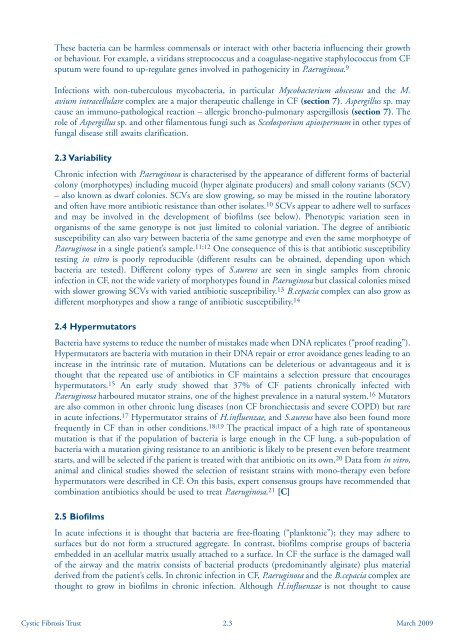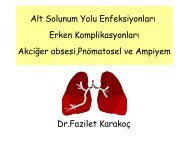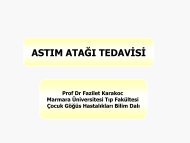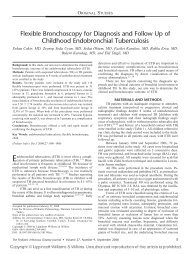Report of the UK Cystic Fibrosis Trust Antibiotic Working Group
Report of the UK Cystic Fibrosis Trust Antibiotic Working Group
Report of the UK Cystic Fibrosis Trust Antibiotic Working Group
Create successful ePaper yourself
Turn your PDF publications into a flip-book with our unique Google optimized e-Paper software.
These bacteria can be harmless commensals or interact with o<strong>the</strong>r bacteria influencing <strong>the</strong>ir growthor behaviour. For example, a viridans streptococcus and a coagulase-negative staphylococcus from CFsputum were found to up-regulate genes involved in pathogenicity in P.aeruginosa. 9Infections with non-tuberculous mycobacteria, in particular Mycobacterium abscessus and <strong>the</strong> M.avium intracellulare complex are a major <strong>the</strong>rapeutic challenge in CF (section 7). Aspergillus sp. maycause an immuno-pathological reaction – allergic broncho-pulmonary aspergillosis (section 7). Therole <strong>of</strong> Aspergillus sp. and o<strong>the</strong>r filamentous fungi such as Scedosporium apiospermum in o<strong>the</strong>r types <strong>of</strong>fungal disease still awaits clarification.2.3 VariabilityChronic infection with P.aeruginosa is characterised by <strong>the</strong> appearance <strong>of</strong> different forms <strong>of</strong> bacterialcolony (morphotypes) including mucoid (hyper alginate producers) and small colony variants (SCV)– also known as dwarf colonies. SCVs are slow growing, so may be missed in <strong>the</strong> routine laboratoryand <strong>of</strong>ten have more antibiotic resistance than o<strong>the</strong>r isolates. 10 SCVs appear to adhere well to surfacesand may be involved in <strong>the</strong> development <strong>of</strong> bi<strong>of</strong>ilms (see below). Phenotypic variation seen inorganisms <strong>of</strong> <strong>the</strong> same genotype is not just limited to colonial variation. The degree <strong>of</strong> antibioticsusceptibility can also vary between bacteria <strong>of</strong> <strong>the</strong> same genotype and even <strong>the</strong> same morphotype <strong>of</strong>P.aeruginosa in a single patient’s sample. 11;12 One consequence <strong>of</strong> this is that antibiotic susceptibilitytesting in vitro is poorly reproducible (different results can be obtained, depending upon whichbacteria are tested). Different colony types <strong>of</strong> S.aureus are seen in single samples from chronicinfection in CF, not <strong>the</strong> wide variety <strong>of</strong> morphotypes found in P.aeruginosa but classical colonies mixedwith slower growing SCVs with varied antibiotic susceptibility. 13 B.cepacia complex can also grow asdifferent morphotypes and show a range <strong>of</strong> antibiotic susceptibility. 142.4 HypermutatorsBacteria have systems to reduce <strong>the</strong> number <strong>of</strong> mistakes made when DNA replicates (“pro<strong>of</strong> reading”).Hypermutators are bacteria with mutation in <strong>the</strong>ir DNA repair or error avoidance genes leading to anincrease in <strong>the</strong> intrinsic rate <strong>of</strong> mutation. Mutations can be deleterious or advantageous and it isthought that <strong>the</strong> repeated use <strong>of</strong> antibiotics in CF maintains a selection pressure that encourageshypermutators. 15 An early study showed that 37% <strong>of</strong> CF patients chronically infected withP.aeruginosa harboured mutator strains, one <strong>of</strong> <strong>the</strong> highest prevalence in a natural system. 16 Mutatorsare also common in o<strong>the</strong>r chronic lung diseases (non CF bronchiectasis and severe COPD) but rarein acute infections. 17 Hypermutator strains <strong>of</strong> H.influenzae, and S.aureus have also been found morefrequently in CF than in o<strong>the</strong>r conditions. 18;19 The practical impact <strong>of</strong> a high rate <strong>of</strong> spontaneousmutation is that if <strong>the</strong> population <strong>of</strong> bacteria is large enough in <strong>the</strong> CF lung, a sub-population <strong>of</strong>bacteria with a mutation giving resistance to an antibiotic is likely to be present even before treatmentstarts, and will be selected if <strong>the</strong> patient is treated with that antibiotic on its own. 20 Data from in vitro,animal and clinical studies showed <strong>the</strong> selection <strong>of</strong> resistant strains with mono-<strong>the</strong>rapy even beforehypermutators were described in CF. On this basis, expert consensus groups have recommended thatcombination antibiotics should be used to treat P.aeruginosa. 21 [C]2.5 Bi<strong>of</strong>ilmsIn acute infections it is thought that bacteria are free-floating (“planktonic”); <strong>the</strong>y may adhere tosurfaces but do not form a structured aggregate. In contrast, bi<strong>of</strong>ilms comprise groups <strong>of</strong> bacteriaembedded in an acellular matrix usually attached to a surface. In CF <strong>the</strong> surface is <strong>the</strong> damaged wall<strong>of</strong> <strong>the</strong> airway and <strong>the</strong> matrix consists <strong>of</strong> bacterial products (predominantly alginate) plus materialderived from <strong>the</strong> patient’s cells. In chronic infection in CF, P.aeruginosa and <strong>the</strong> B.cepacia complex arethought to grow in bi<strong>of</strong>ilms in chronic infection. Although H.influenzae is not thought to cause<strong>Cystic</strong> <strong>Fibrosis</strong> <strong>Trust</strong> 2.3March 2009






